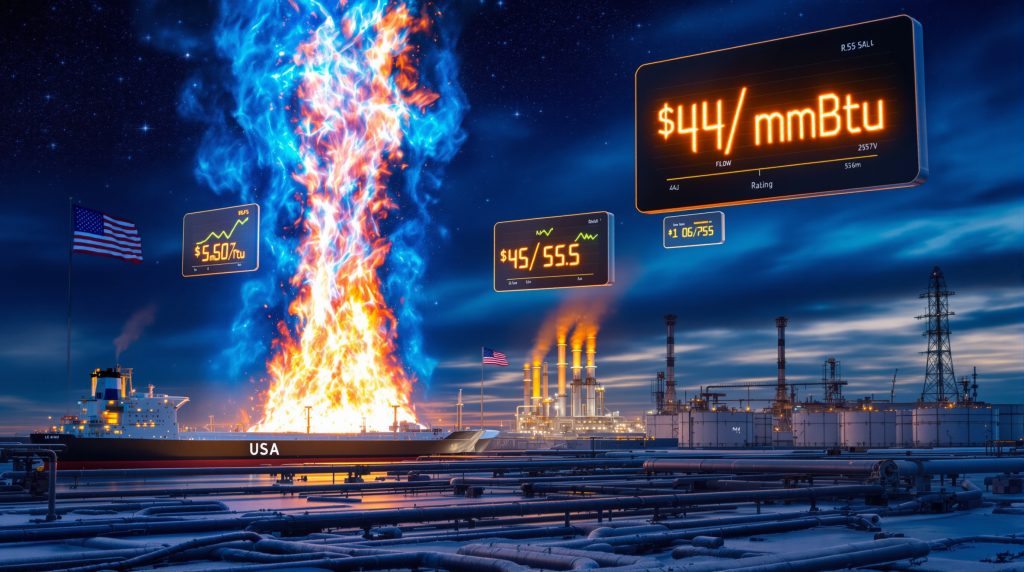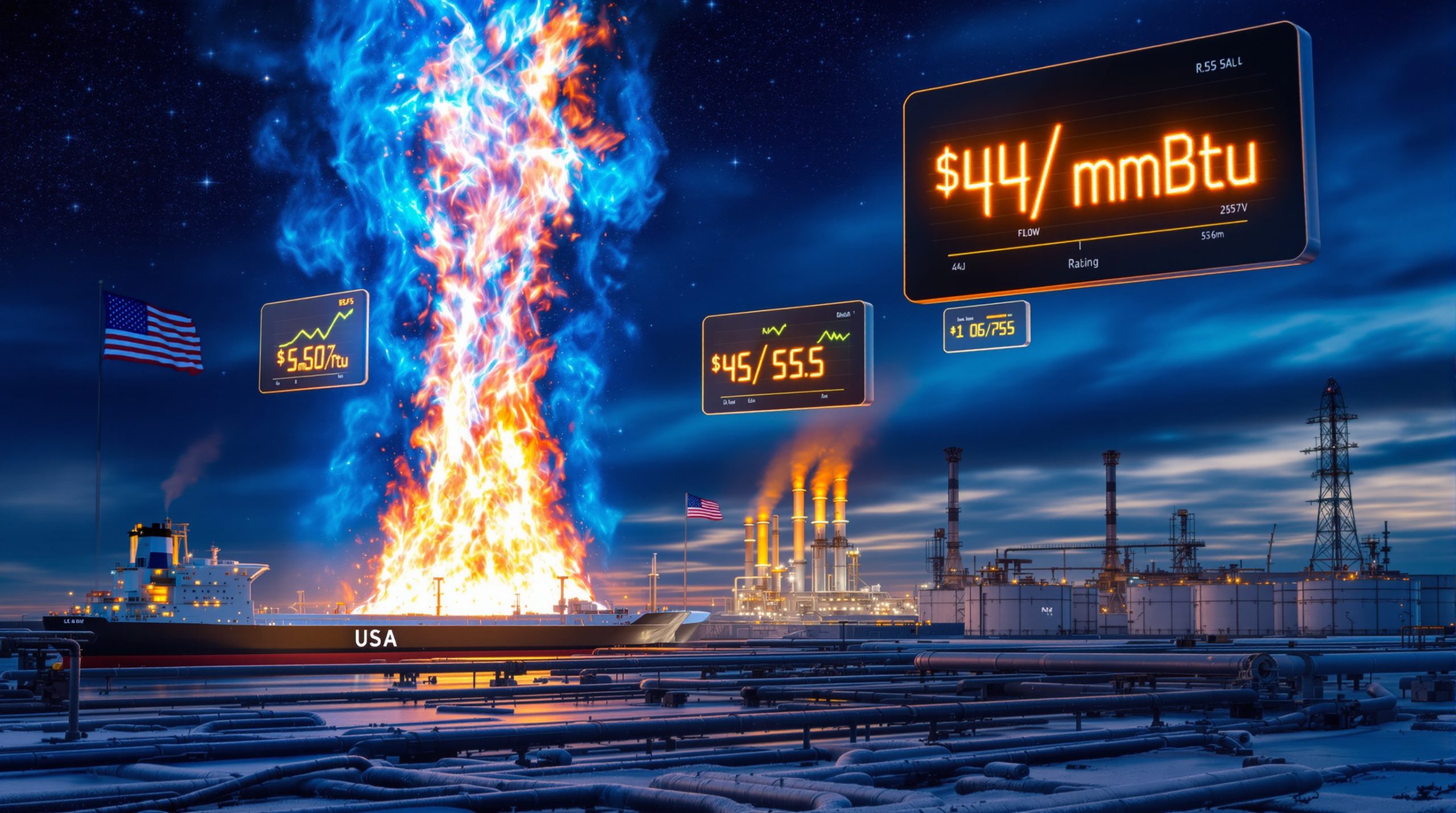How Market Dynamics Are Shifting from Storage Concerns to Supply Tightness
U.S. natural gas futures surge on supply tightness, experiencing a remarkable 17.3% surge last week, marking the largest weekly gain since early May 2025. This significant price movement reflects a fundamental shift in market sentiment and underlying supply-demand dynamics. As winter approaches, traders and analysts are recalibrating their expectations for the natural gas market.
Key Market Indicators Driving the Rally
November futures contract reached nearly $3.5/mmBtu, a critical resistance level that had previously constrained price growth. This breakthrough signals renewed market confidence in natural gas valuations.
Weekly storage build came in below analyst expectations at just 53 billion cubic feet (Bcf) versus forecasts of 64 Bcf, suggesting stronger underlying demand than previously anticipated.
LNG export demand has increased substantially, creating a sustainable price floor for domestic natural gas prices regardless of seasonal fluctuations.
Calendar 2026 futures contracts exceeded $4/mmBtu for the first time in two months, revealing longer-term bullish sentiment among market participants.
Why Has the Market Narrative Changed So Dramatically?
The natural gas market has pivoted from concerns about potential storage congestion to growing anxiety about future supply tightness. This transformation in market sentiment has several underlying causes that extend beyond typical seasonal factors.
Storage Congestion Fears Have Subsided
Recent data suggests that earlier concerns about Gulf storage facilities reaching capacity have not materialized. Cash prices at Henry Hub have maintained relatively stable levels above $2.70/mmBtu, even during periods of typically weaker demand such as the Labor Day holiday weekend. This price resilience indicates that weekly storage injections have remained at manageable levels.
The Energy Information Administration's recent report showed a smaller-than-expected increase in natural gas inventories, with storage rising by only 53 billion cubic feet (Bcf) versus forecasts of 64 Bcf. This lower injection rate has helped alleviate concerns about running out of storage capacity before the winter heating season begins.
LNG Export Demand Reaches New Heights
A significant factor supporting higher natural gas prices has been the substantial increase in liquefied natural gas (LNG) export volumes. The LNG supply outlook suggests continued strong demand through 2026 and beyond:
| LNG Facility | Recent Developments | Capacity Impact |
|---|---|---|
| Venture Global's Plaquemines | Gas demand approaching full capacity | 3.6 Bcf/d |
| Cheniere's Corpus Christi | Expansion showing increased gas pull | Contributing to record exports |
| Cove Point | Expected return from maintenance by mid-October | Will further boost export capacity |
Total U.S. gas demand for LNG exports has climbed above 16.5 Bcf/d, reaching the highest level since early August. Industry analysts project this figure will sustainably exceed 17 Bcf/d by mid-October once maintenance activities at key facilities conclude.
How Are Storage Dynamics Affecting Market Sentiment?
Salt Cavern Storage Levels Remain Manageable
Salt cavern storage facilities, which offer the highest deliverability rates in the U.S. natural gas infrastructure system, have maintained manageable inventory levels. The EIA even reported an atypical withdrawal from these facilities last week, contrary to the usual injection pattern during this time of year.
This unexpected withdrawal suggests stronger-than-anticipated demand or strategic inventory management by storage operators anticipating higher future prices.
Potential Short-Term Price Pressures
Despite the bullish sentiment, market analysts note that temporary factors could create short-term price volatility:
"We may see temporary downward pressure on prices due to a combination of increasing production and reduced pipeline exit flows from the Gulf, largely driven by maintenance events."
These maintenance-related disruptions could temporarily weigh on U.S. gas prices from current levels but are unlikely to reverse the broader market trend toward higher prices.
What Does the Heating Season Outlook Suggest for Prices?
As winter approaches, approximately 42% of U.S. households—particularly those in the Midwest and Northeast regions—rely on natural gas as their primary heating source. This seasonal demand surge typically supports higher prices during the winter months.
Regional Heating Demand Factors
The heating season creates significant regional demand variations:
Northeast: Heavily dependent on natural gas for heating, with limited pipeline capacity creating potential price spikes during cold snaps
Midwest: Strong reliance on natural gas with better infrastructure but still vulnerable to extreme cold events
South: Growing but less intensive heating demand compared to northern regions
West: Mixed heating profile with significant regional variations
Weather Forecast Implications
Current weather forecasts suggest potential for colder-than-average temperatures in key consuming regions, which could accelerate the drawdown of stored gas inventories. Early cold weather events could particularly impact market psychology, potentially accelerating the price rally.
What Are Analysts Forecasting for 2026 Natural Gas Markets?
Market participants are increasingly focused on potential supply constraints in 2026, with the calendar year 2026 futures strip recently settling above $4/mmBtu for the first time in two months.
Production Growth Concerns
While current U.S. natural gas production remains near record levels, there are growing concerns about sustained production growth:
- Declining rig counts in some regions suggest potential moderation in supply growth
- Capital discipline among producers limits aggressive expansion plans
- Geological constraints in some mature production areas
- Infrastructure limitations for moving gas from production areas to demand centers
Long-Term Price Forecasts
Leading financial analysts maintain their forecasts for Henry Hub prices:
- $4.00/mmBtu for November-December 2025
- $4.60/mmBtu for Calendar Year 2026
These projections reflect expectations that the market will increasingly focus on tightening supply concerns as the heating season progresses.
How Might Production Respond to Higher Prices?
Natural gas producers typically respond to sustained higher prices by increasing drilling activity, but several factors complicate this traditional response mechanism.
Capital Discipline Constraints
Following years of volatile prices and financial challenges, many natural gas producers have adopted strict capital discipline policies that prioritize shareholder returns over production growth. This approach limits the speed and scale of production increases even when prices rise.
Infrastructure Limitations
Even if producers increase drilling activity, pipeline capacity constraints in key production regions could limit the ability to bring additional supply to market. These bottlenecks are particularly significant in the Appalachian Basin, which accounts for approximately one-third of U.S. natural gas production.
Technological Improvements
Ongoing technological advancements in drilling and completion techniques continue to enhance well productivity and reduce costs. These improvements could enable producers to respond more efficiently to price signals, potentially moderating price increases.
What Are the Global Implications of U.S. Natural Gas Price Trends?
The United States has emerged as a major global supplier of natural gas through LNG exports, creating stronger linkages between domestic and international markets.
International Price Comparisons
U.S. natural gas prices remain substantially lower than prices in Europe and Asia, supporting continued strong export demand. Furthermore, ongoing US‑China trade tensions continue to impact global energy flows and pricing dynamics:
| Market Region | Current Price Range ($/mmBtu) |
|---|---|
| U.S. (Henry Hub) | $3.00-3.50 |
| Europe (TTF) | $10.00-12.00 |
| Asia (JKM) | $11.00-13.00 |
This price differential creates strong economic incentives for continued high levels of U.S. LNG exports, further supporting domestic prices.
Geopolitical Considerations
The role of U.S. natural gas in global energy security dynamics has grown substantially, particularly for European markets seeking alternatives to Russian supply. This geopolitical dimension adds another layer of support for sustained export volumes regardless of price fluctuations.
FAQ: Understanding the Natural Gas Price Rally
Why are natural gas prices rising despite record U.S. production?
While production remains high, the market is increasingly focused on future supply-demand balances rather than current production levels. Growing export demand, potential production growth limitations, and expectations for normal to colder winter weather are outweighing the impact of current strong production.
How might storage levels impact prices through winter?
Current storage levels remain adequate but not excessive. If winter weather proves colder than normal, the market could quickly shift from comfort to concern about adequate supplies, potentially driving prices significantly higher, according to the EIA's natural gas weekly report.
What role do LNG exports play in domestic price formation?
LNG exports effectively create a price floor for U.S. natural gas by connecting domestic supplies to higher-priced international markets. As export capacity continues to grow, this influence on domestic prices will likely strengthen.
Could regulatory changes impact the natural gas market outlook?
Potential changes in environmental regulations, pipeline permitting processes, or export authorization procedures could significantly impact both supply and demand dynamics. Market participants closely monitor these policy developments for signals about future market conditions.
Conclusion: Market Focus Shifting to Long-Term Supply Concerns
The recent surge in U.S. natural gas futures surge on supply tightness represents more than a typical seasonal rally. It signals a fundamental shift in market perception from concerns about near-term storage congestion to growing anxiety about longer-term supply adequacy.
As the heating season approaches, market participants appear increasingly convinced that the balance between supply and demand will tighten, particularly looking ahead to 2026. While temporary factors may create price volatility in the near term, the underlying trend suggests a market that is repricing to reflect expectations of a tighter supply-demand balance.
For consumers, producers, and traders alike, this evolving market narrative suggests a period of potentially higher and more volatile natural gas prices ahead, particularly if winter weather proves colder than normal or if production growth fails to keep pace with expanding demand. According to Forbes analysis, these industry evolution trends will likely define energy markets well into 2026 and beyond.
Want to Stay Ahead of Major Market Movements?
Discovery Alert's proprietary Discovery IQ model delivers real-time notifications on significant ASX market opportunities, turning complex data into actionable insights for traders and investors alike. Visit our discoveries page to see how early identification of market shifts can lead to substantial returns before the broader market reacts.




